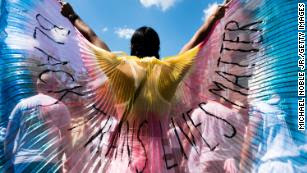Oct 21, 2021, 10:00am Caroline Reilly
National Advocates for Pregnant Women painted a grim picture of pregnant people increasingly being prosecuted around the country for a miscarriage.
The criminalization of Brittney Poolaw’s pregnancy forewarns of a system where all pregnancies that do not end in a live birth can be deemed suspicious.
In January 2020, then-19-year-old Brittney Poolaw was pregnant and needed urgent medical care. She called 911 and was taken to the hospital in an ambulance. She was having a miscarriage at 17 weeks.
Two months later, she was arrested and charged with first-degree manslaughter under Oklahoma law. Earlier this month—after spending 18 months in jail because she could not afford her $20,000 bond—Poolaw, now 21, was sentenced to four years in prison for her pregnancy loss. National Advocates for Pregnant Women (NAPW), which represents Poolaw, say this case is not an outlier—it’s one of over 1,000 such cases across the country in recent years.
The criminalization of adverse pregnancy outcomes—arresting, charging, and incarcerating pregnant people for miscarriages and stillbirths—might seem dystopian, like a plot point from a horror or sci-fi movie. Occasionally, cases like Poolaw’s make national headlines and are rightly judged as ghastly violations of human rights and autonomy. But that laser focus on individual cases can give the impression that these are isolated incidents.
They are not.
NAPW say cases like Poolaw’s have been on the rise in recent years. According to their analysis, from 1973 to 2005 there were at least 413 cases in which a woman’s pregnancy or pregnancy outcome was a determinative factor in her loss of liberty. Since 2005 that number has tripled to over 1,200, indicating a rapid escalation of these types of arrests.
This is despite every major medical organization in the country opposing the use of the legal system to penalize pregnancy loss, and despite studies showing that criminalization of adverse pregnancy outcomes may actually deter pregnant people from seeking medical care, which in turn puts them and their pregnancies at greater risk.
Speaking to Rewire News Group, Dana Sussman, NAPW’s deputy executive director, and NAPW staff attorney Cassandra Kelly painted a grim picture of pregnant people increasingly being prosecuted for charges involving fetal demise. This is happening across the country, in states like Wisconsin, Alabama, and California; for the latter, they cited the cases of Chelsea Becker, who spent over a year incarcerated after being charged with murder for experiencing a stillbirth, and Adora Perez, who is serving an 11-year sentence for a similar charge.
An even more radical framework for criminalizing miscarriage
Describing Poolaw’s case, Sussman said, “I’m not sure if I have the words to describe frankly how problematic this case has been from start to finish.”
Prosecutors argued that Poolaw’s drug use was to blame for her pregnancy loss. When she sought medical attention for her miscarriage, she told hospital staff that she had used meth and marijuana. The medical examiner’s report listed maternal meth use as a contributing factor to fetal demise, but didn’t determine it was directly responsible. And even an OB-GYN testifying for the prosecution said that while drug use can have an effect on pregnancy, it’s unclear what caused the miscarriage in this case.
Under Oklahoma law, manslaughter and murder laws can be applied to a viable fetus, as can child abuse and neglect laws. But Poolaw’s miscarriage occured when she was 17 weeks pregnant, long before a fetus reaches viability. NAPW advocates say Poolaw’s case is one of the earliest they’ve seen; by prosecuting a pre-viability miscarriage as manslaughter, Oklahoma prosecutors are pushing the law’s bounds, indicating a shift toward an even more radical framework for criminalizing pregnancy loss.
NAPW is a nonprofit organization that does pro bono criminal defense, advocacy, public education, and organizing around the criminalization of pregnancy loss.
The particulars of Poolaw’s case are a web of legal booby traps. “There has to be a causal link when we’re talking about manslaughter,” Sussman said. “In Brittney’s case, it was ‘possession of an illegal substance.’ Of course, possession on its own, even by their framing, wouldn’t cause fetal demise. It’s the consumption, but in Oklahoma, from what we understand, possession has essentially been construed as also covering consumption.”
What we see happening with the criminalization of pregnancy loss is not unlike what we see with the increasingly volatile state of abortion access in the country. Lawmakers and prosecutors start by encroaching on the bodily autonomy of pregnant people in a way they know will be most palatable to society. They target circumstances most fraught with stigma and taboo: later abortion bans, restrictions on young people accessing abortion, criminalization of drug use during pregnancy. But Sussman says they will not stop there.
It comes down to prosecutors claiming the pregnant person put the fetus at “risk of harm,” she said, a measure of liability with drastic potential for expansion.
“We’ve tracked all cases that we can find in which someone has been arrested and/or prosecuted or experienced another deprivation of liberty in relation to their pregnancy, and the vast majority of those cases involve drug use,” Sussman said. “It’s not all though. So, we do see cases where someone fell down a flight of stairs and was charged with some criminal allegation creating a risk of harm to the fetus.”
But NAPW wants to make clear that pushing back against the criminalization of pregnancy loss isn’t about viability or substance use; pointing out these legal intricacies is not to concede that viability or the pregnant person’s behavior should be used to determine whether manslaughter or other criminal charges are appropriate.
Instead, NAPW staff stress that the criminalization of any pregnancy loss is wrong. If lawmakers and prosecutors intended to stop with cases involving post-viability pregnancies, or miscarriages involving allegations of drug use, that would still warrant the abject horror that Poolaw’s case has been greeted with.
“It is a slippery slope. We are on the slope.”
A critical part of this case is Poolaw’s Indigenous background—she is a member of Comanche Nation; the history of the criminalization of adverse pregnancy outcomes is, unsurprisingly, deeply rooted in racism and classism.
“So much of this has its tentacles in the ‘crack baby’ obsession in the ‘80s and ‘90s targeting poor Black women,” Sussman said. She cites a 1989 policy in which the Medical University of South Carolina entered into an agreement with local law enforcement to surreptitiously drug test and report pregnant women, so that police could arrest them days and sometimes just hours after giving birth. The population that the hospital was serving at the time was predominantly Black and lower income.
According to the Center for Reproductive Rights, which challenged the policy in court:
Some women were taken to jail while still bleeding from giving birth. Others were arrested and jailed while they were pregnant, even though the prison could not provide prenatal care or drug treatment. When the incarcerated women went into labor, they were returned to the hospital in shackles. One woman was handcuffed to her bed throughout her delivery.
The Supreme Court heard the Center’s challenge to the policy and, in 2001, ruled in their favor. But the same type of disparate impact remains the reality of criminalized adverse pregnancy outcomes today. Sussman stresses that cases like Poolaw’s will affect marginalized pregnant people most—Black, trans and nonbinary, disabled, undocumented, and lower income pregnant people are all at an increased risk of having their pregnancy losses criminalized.
“We all know that pregnancy is grossly understudied and there’s so much still unknown,” Sussman says. “Exercising too vigorously, going downhill skiing, a lot of things [involve risk], but because of the war on drugs and because of racism and because of classism and lots of other things, the focus has been disproportionately on drug use. But it is a slippery slope. We are on the slope.”
Criminalization of pregnancy loss is rapidly expanding in scope, in ways that continue to target marginalized people. Sussman said NAPW is now seeing cases where a pregnant person faces allegations of lack of prenatal care as part of a larger charge. This is particularly insidious considering which communities lack access to proper prenatal care, and the fact that for low-income families, accessing prenatal care means interacting with a state system that has the potential to surveil them, which in turn leaves them vulnerable to prosecution if they experience pregnancy loss. NAPW is even starting to see cases where parents of newborns become ensnared in the legal system for allegations of drug use during breastfeeding.
Poolaw’s case forewarns of a system where all pregnancies that do not end in a live birth can be deemed suspicious. As Texas SB 8, which bans nearly all abortions after a fetal heartbeat is detected, dominates headlines, it’s critical to understand how criminalizing abortion and criminalizing pregnancy loss intersect. Conservatives in Texas have been quick to assure voters that pregnant people themselves cannot be charged under the anti-abortion law, but the reality is that pregnant people around the country are already being charged for not carrying a pregnancy to term. And while medication abortion is safe and effective, an increased demand for it presents unique challenges to populations of pregnant people who are more likely to have their pregnancy losses criminalized.
The increasing criminalization of adverse pregnancy outcomes also speaks to a deep-seated stigma and taboo surrounding miscarriage and infertility.
“It’s premised on this false notion that everyone can guarantee a healthy pregnancy and that it is somehow your failure, your incapacity, your fault, something you did or something you didn’t do, that caused the pregnancy loss,” Sussman said.
“We of course know how common pregnancy loss is and how it’s been really sort of understudied, as so many sort of health issues that predominantly affect women are, and thinking about sort of all of the economic, social, structural reasons why people might experience pregnancy loss … And yet here we are holding women criminally liable when they can’t guarantee a healthy pregnancy.”
Sussman said Poolaw now has a short window of time to decide whether to appeal. Four years is the minimum sentence for manslaughter in Oklahoma, and she could have gotten life in prison, Sussman said.
“I think she has been through a deeply, deeply traumatic experience,” Sussman said. “It’s trauma layered upon trauma. And so we’re going to be driven by what she wants. But regardless of what decision she makes, it’s not the end of our fight in Oklahoma because more cases are coming.”









